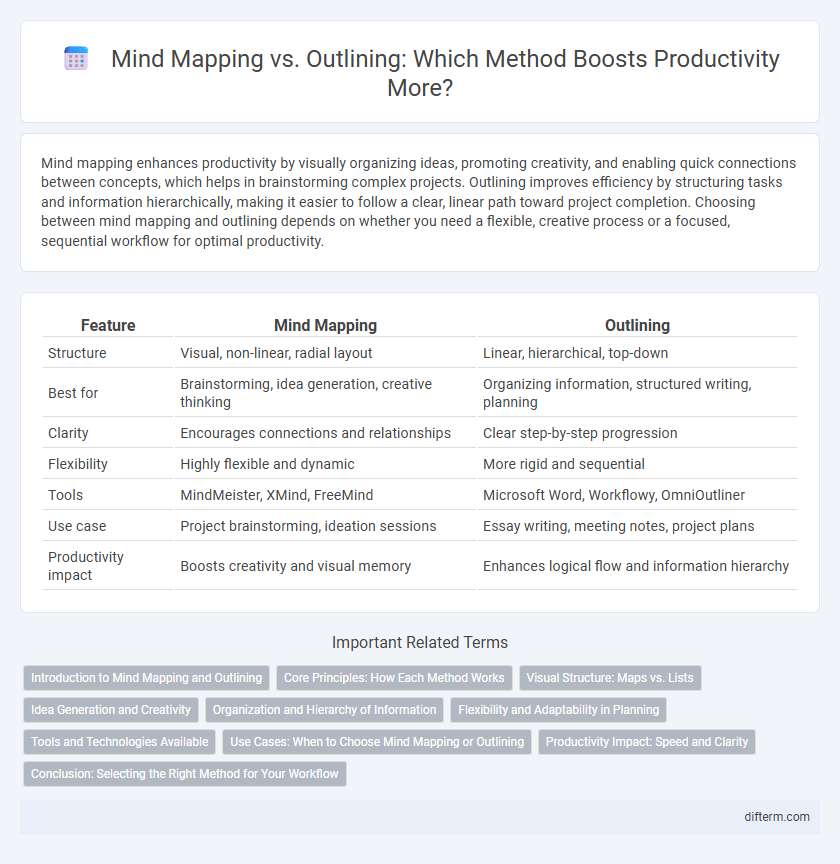Mind mapping enhances productivity by visually organizing ideas, promoting creativity, and enabling quick connections between concepts, which helps in brainstorming complex projects. Outlining improves efficiency by structuring tasks and information hierarchically, making it easier to follow a clear, linear path toward project completion. Choosing between mind mapping and outlining depends on whether you need a flexible, creative process or a focused, sequential workflow for optimal productivity.
Table of Comparison
| Feature | Mind Mapping | Outlining |
|---|---|---|
| Structure | Visual, non-linear, radial layout | Linear, hierarchical, top-down |
| Best for | Brainstorming, idea generation, creative thinking | Organizing information, structured writing, planning |
| Clarity | Encourages connections and relationships | Clear step-by-step progression |
| Flexibility | Highly flexible and dynamic | More rigid and sequential |
| Tools | MindMeister, XMind, FreeMind | Microsoft Word, Workflowy, OmniOutliner |
| Use case | Project brainstorming, ideation sessions | Essay writing, meeting notes, project plans |
| Productivity impact | Boosts creativity and visual memory | Enhances logical flow and information hierarchy |
Introduction to Mind Mapping and Outlining
Mind mapping visually organizes ideas around a central concept, promoting creativity and nonlinear thinking, while outlining arranges information hierarchically in a structured, linear format. Mind maps use branches and keywords to capture relationships, enhancing memory and idea generation, whereas outlines emphasize logical order and prioritization for clear, concise communication. Both techniques improve productivity by catering to different cognitive styles and task requirements in project planning and knowledge management.
Core Principles: How Each Method Works
Mind mapping enhances productivity by visually organizing ideas around a central concept, promoting nonlinear thinking and creative connections through branches and keywords. Outlining improves task management by structuring information hierarchically with headings and subheadings, facilitating logical flow and clarity. Both methods rely on core principles of information organization but engage different cognitive processes to boost understanding and efficiency.
Visual Structure: Maps vs. Lists
Mind mapping presents ideas through a visual, non-linear structure with branches radiating from a central concept, allowing for intuitive association and creativity. Outlining arranges information hierarchically in linear, numbered lists, emphasizing order and prioritization. This contrast highlights mind mapping's strength in fostering idea generation and flexibility, while outlining excels in clarity and logical organization for productivity.
Idea Generation and Creativity
Mind mapping enhances idea generation and creativity by visually organizing thoughts into interconnected nodes, promoting nonlinear thinking and fostering innovative connections. Outlining structures ideas hierarchically, which supports clarity and logical progression but may limit spontaneous creativity. For maximizing creative potential during brainstorming, mind mapping offers a dynamic and flexible approach compared to the more rigid framework of outlining.
Organization and Hierarchy of Information
Mind mapping visually organizes information by connecting ideas through branches radiating from a central concept, allowing for nonlinear exploration and creative association. Outlining structures information in a linear, hierarchical format with main topics and subtopics arranged sequentially, facilitating clear prioritization and logical progression. Choosing between mind mapping and outlining depends on whether a user needs flexible idea generation or a strict, detailed framework for presenting information.
Flexibility and Adaptability in Planning
Mind mapping offers greater flexibility and adaptability in planning by allowing free-form organization of ideas, which facilitates creative thinking and easy restructuring. Outlining provides a more rigid, linear framework that excels in organizing complex information into hierarchical, sequential order, ensuring clarity and logical flow. Choosing between them depends on whether the task requires dynamic idea generation or structured, detailed planning.
Tools and Technologies Available
Mind mapping tools like MindMeister and XMind offer interactive visual interfaces that enhance idea organization through nodes and branches, facilitating creative brainstorming processes. Outlining software such as Microsoft OneNote and Workflowy provides structured, hierarchical frameworks ideal for detailed project planning and linear note-taking. Emerging technologies integrating AI, like Notion AI, combine both approaches, allowing users to switch seamlessly between visual mind maps and traditional outlines for optimized productivity workflows.
Use Cases: When to Choose Mind Mapping or Outlining
Mind mapping excels in brainstorming sessions and creative projects by visually organizing ideas and revealing connections between concepts, making it ideal for exploring complex topics and generating new insights. Outlining is best suited for structured tasks such as writing reports, preparing presentations, or managing workflows, where a clear hierarchy and sequential order of information are essential. Choosing between mind mapping and outlining depends on whether the goal is to foster creative thinking or to establish a systematic framework for logical progression.
Productivity Impact: Speed and Clarity
Mind mapping accelerates idea generation through visual branching, enhancing clarity by showing relationships between concepts at a glance. Outlining structures information linearly, boosting speed in organizing hierarchical content and improving clarity with clear, sequential logic. Both techniques enhance productivity, with mind mapping excelling in brainstorming and outlining optimizing detailed planning.
Conclusion: Selecting the Right Method for Your Workflow
Choosing between mind mapping and outlining depends on whether you prioritize creative idea generation or structured organization in your workflow. Mind mapping excels at visualizing connections and fostering brainstorming, while outlining provides a clear, hierarchical framework ideal for detailed planning. Aligning your method with your project requirements and cognitive style enhances productivity and clarity in task management.
Mind mapping vs Outlining Infographic

 difterm.com
difterm.com